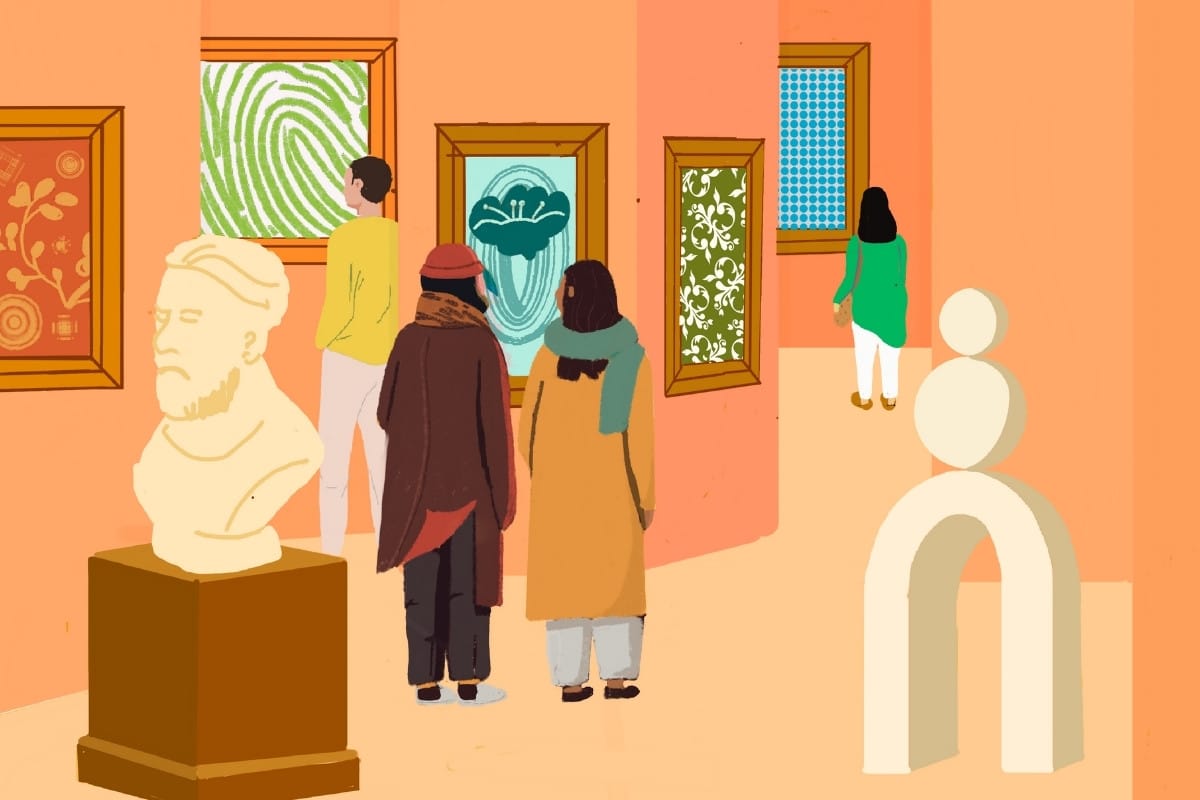We know that creativity is beneficial for mental health, but research suggests that simply enjoying artwork at a more measured pace can be powerful, too
Have you heard of ‘frisson’? Otherwise known as aesthetic thrills or feeling awestruck, it’s a sensation of intense emotional pleasure, appreciation, or being overcome by beauty. Frisson is often accompanied by goosebumps and, sometimes, happy tears. You may have felt it when listening to live music, enjoying a breath-taking view, or observing a work of art. Maybe you experienced frisson basking in the light of Monet’s Water Lilies at Musée de l’Orangerie in Paris, or gazing at Botticelli’s The Birth of Venus at the Uffizi Gallery in Florence.
For most of us, frisson is something that happens unexpectedly and rarely. But what if there was a way you could experience this feeling more? The answer may lie in the art of ‘slow looking’.
What is slow looking?
Slow looking is the act of observing an artwork for an extended period of time. That could be an uninterrupted five minutes, an hour, or even an entire day. According to the Tate galleries: “It is an approach based on the idea that, if we really want to get to know a work of art, we need to spend time with it.”
Cima Azzam, curator at Maraya Art Centre in the United Arab Emirates, says: “Slow looking creates room to appreciate the artistic practice, process, and time it took to conceive artwork. Art is a language of its own, so taking the time to look intently and slowly, allowing your eyes to wander, sparks a connection.”
Cima describes the shift she’s seen in how visitors engage with art, particularly in museums. “You often see people sitting in one hall for hours on end, in front of one artwork, completely unaware and unaffected by the rush of crowds sweeping through.”
In 2023, Rebecca Chamberlain, a psychologist specialising in art perception, and Aleksandra Igdalova, a psychology researcher and neuroaesthetics consultant, published their research on slow looking, in Psychology of Aesthetics, Creativity, and the Arts. Their findings suggest that it leads to significant short-term mood improvements, with participants reporting feeling more pleasant and relaxed after viewing artworks for extended periods.
The research also found that the effectiveness of slow looking depends on the approach used – specifically, providing art historical information during viewing led to greater cultural understanding and engagement, compared to meditation-based or control conditions. Additionally, the study found that representational artworks (as opposed to abstract) were most frequently chosen by participants, and contributed to higher overall aesthetic experience scores, indicating that certain kinds of art may be better suited for slow looking than others.
To try something similar, Cima recommends going to an art exhibition after the main opening event, when there are fewer people. “I prefer to go when it’s quiet,” she says, “to better absorb the art, concepts, and forms.
“It’s more about time – spending time with art and giving it your full attention, whether it’s a sculpture, painting, or film – and giving yourself time to engage with the artwork with intention.”

While slow looking can boost enjoyment in a gallery setting, this isn’t always an available option. So, is there a way to reap the benefits in everyday life? According to UK Council for Psychotherapy-accredited psychotherapist Tina Chummun, the answer is yes.
Rewild your attention span
Not only does slow looking help us become more present, aware of our surroundings, and engaged with our senses, but it’s a great stress reliever. According to Tina, slow looking encourages us to resist the fast-paced, dopamine-driven grasp of modern tech culture and, instead, to dwell a little longer. “This kind of attentiveness activates the prefrontal cortex, responsible for executive functioning and regulation, and slows our amygdala activity, lowering stress responses,” she says.
When we’re feeling overstimulated from doomscrolling, work stress, responsibilities at home, or general busyness, the act of slow looking is something that our minds and bodies crave. It steers our focus away from the tantalising (often toxic) digital world, and grounds us back in the physical. Tina says: “Slow looking becomes a rewilding of attention.”
Is slow looking similar to meditation?
Kind of. Not confined to the cushion, breath, and closed eyes – keeping your focus purely inward – slow looking takes us out into the world, and immerses us in the sensory realm. Tina explains: “It is meditative, yes, but also embodied, relational, and deeply neurobiological – helping recalibrate a nervous system that is caught in the chronic ‘doing’ mode.”
In many ways, it’s the art of simply noticing, without distractions, and without giving in to the urge to make it a ‘productive’ activity. It should be unrushed, intentional, and rooted in childlike curiosity.
How to try slow looking
Tina suggests looking for opportunties to weave the smallest of rituals into regular tasks you already do, whether it be “studying the texture of your morning toast, tracing the lines on a loved one’s face, or watching how the light shifts on the wall throughout the afternoon”.
Slow looking might take some time to get used to. It’s a skill that has to be practised, but it’s something you can start adding to your life today. Whether it’s observing a work of art, gardening, staring out the window during your next train journey, birdwatching, or pausing during a woodland walk to observe the plant life around you, there are countless ways to slow look every day.

The mental health benefits of slow looking
The benefits of slow looking and intentionality are both somatic and psychological. “When we slow down, we invite the parasympathetic nervous system, the ‘rest and digest’ mode, to rise up and balance us,” explains Tina. “This shift reduces cortisol levels, improves vagal tone, and supports neuroplasticity in brain regions involved in emotional regulation.
“Consider the humble garden swing chair, or an old rocking chair,” says Tina. “As we settle into the rhythm of rocking – forward, back, forward again – the vestibular system is gently stimulated. This ancient sensory system, located in the inner ear, has strong links to autonomic regulation, balance, and even our sense of time. As we swing, the rhythmic motion coaxes the nervous system into regulation – a biological lullaby.”
This soothing of the mind creates space for new thoughts, ideas, and feelings to surface, and it’s in this space where slow looking comes into effect. This is when you might start to notice subtleties in your environment, like leaves rustling in the wind, the wingbeats of a bird passing overhead, the morphing shape of the clouds, or the calming trickle of rain. Tina adds: “Rather than rushing to interpret or judge, you simply see. You become the witness,” which causes “a subtle yet profound neurocognitive shift that supports reduced anxiety, and enhanced mental health and overall wellbeing”.


Comments